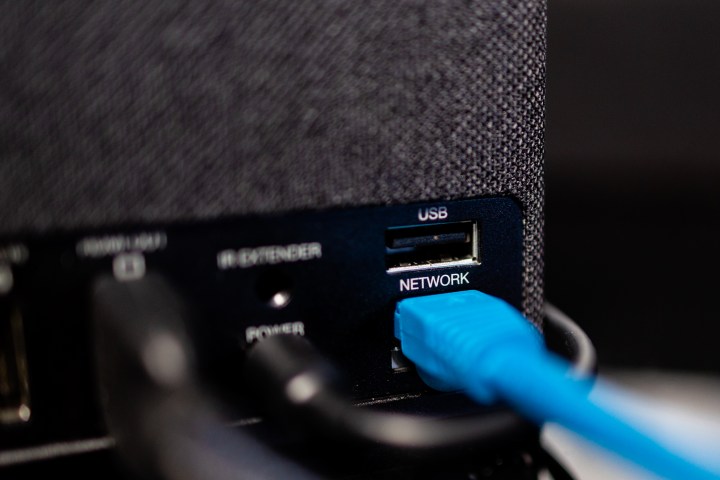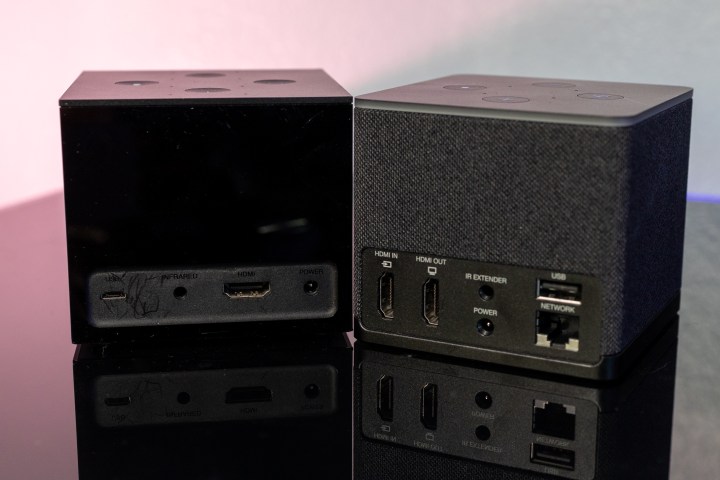The latest Amazon Fire TV Cube is good. Really good, even, with the addition of HDMI-in that allows for even better control of things like cable and satellite set-top boxes. Same, too, goes for the addition of USB-A and a full-blown Ethernet port.
But it’s that latter feature that many a reader of our Fire TV Cube review (and our Fire TV Omni QLED review, too) has had stuck in their craw.

First, a little context. Ethernet is a great option to have. Yes, even in this golden age of Wi-Fi, and even as the Fire TV Cube itself has added support for Wi-Fi 6E, the latest standard is faster and just better than what came before it. Never mind the fact that only the newest of routers supports it — that’s a problem for another day, and future-proofing a device in this way is a good thing.
Regardless, physically connecting your device to your network via Ethernet is almost always better than going wireless. If it’s not an inconvenience to do so, we suggest you plug it in.
The previous two models of Fire TV Cube, initially released in 2018 and updated a tad a year later, supported Ethernet via a Micro USB dongle. That’s not ideal since it requires you to first purchase said dongle (which Amazon itself was happy to sell you), and it also requires you to plug one more thing into a device that almost certainly had the internal room to spare.
So the addition of a full Ethernet port in the latest Fire TV Cube is a good thing.
Just one problem, though. The port itself is what’s known as a 10/100 port, also known as Fast Ethernet. That means you’re not going to get beyond the theoretical speed of 100Mbps of data flowing through. And note that we’re talking about megabits per second in that 10/100 number, not megabytes. We’re talking speed, not file size.
For contrast, the top theoretical speed of Wi-Fi 6E on the Fire TV Cube is a ridiculous (but awesome) 9.6Gbps. Note the uppercase G there for gigabits, not megabits. That’s a lot more data moving around.

In other words, you almost don’t want to plug the Cube into your router if what you’re worried about is pure theoretical data throughput (and if you have a Wi-Fi 6E router). And to be fair to the Fire TV Cube, this isn’t the only time we’ve seen this happen. It’s a basic numbers game at this point. Anything running Wi-Fi 4 (previously known as 802.11n) and newer has a higher theoretical wireless speed than what a 10/100 connection will get you.
Does any of this even matter? Yes and no.
It matters if you’re the sort who demands that every feature on a brand-new device be the latest and greatest without understanding that every design decision has a trade-off, be it money or heat or something else altogether. Hardware is hard. We’ll call this the Veruca Salt frame of mind. You might not like that a device has lesser specs, but that doesn’t mean it wasn’t done for a reason, even if you don’t agree with it.
It matters if you need something beyond 100Base/TX for whatever reason, be it speed, capacity, or distance. If you even know what 100Base/TX is, you’ve likely been rolling your eyes for some time, and that’s fine. (If you need it for the Fire TV Cube? Well, we should talk.)
And, fine, it maybe matters if you’re going to be pushing content in 8K resolution, which you almost assuredly are not. You’re definitely not streaming it yet, anyway.
But it doesn’t matter if you understand that you do not need Gigabit Ethernet to do anything you expect the Fire TV Cube to do today, in 2022. Or likely in 2023 or 2024. Probably in 2025, too. You don’t need it to stream Netflix movies in 4K; a paltry 15Mbps should do, Netflix says. You don’t need it to play games on Luna, Amazon’s streaming gaming platform; 10Mbps is fine for that. Pick another normal use case. Same answer.
In fact, Amazon says pretty much the same thing. In an emailed response as we were wrapping up this piece, we were told the reasoning behind the 10/100 Ethernet port was that “10/100 Ethernet is sufficient to meet the throughput requirements for all primary Cube use cases including the most demanding streaming use case — 4K 60 fps [Dolby Vision] with Atmos and Picture-in-Picture.”
In addition, Amazon — which absolutely knows whether you’re using Wi-Fi or Ethernet with its devices — said that “the majority of our customers prefer Wi-Fi over wired ethernet and therefore we biased toward investing in Wi-Fi 6E that drives Gigabit speeds over Wi-Fi instead.”
Also, it makes perfect sense when you remember that the , as the name suggests, supports Wi-Fi 6E. And Eero is owned by Amazon. So it may be as simple as that.
- 1. A speed test on the 2021 model of Apple TV 4K at upward of 900Mbps, with Ethernet connected.
- 2. A 93Mbps speed test on the Amazon Fire TV Cube when connected via Ethernet.
Look at the examples above. On the left is the Apple TV 4K (2021 model) with Gigabit Ethernet. On the right is the Amazon Fire TV Cube with Fast Ethernet. Both are connected via Ethernet to the same switch and router. Apple TV is roughly 10 times faster. But does it stream video 10 times faster? Or better? Or in any discernible way?
Would Gigabit Ethernet be nice to have? Sure. Is it necessary? Nope.
Your home internet connection — which is not the same thing as Ethernet speed — has more to do with any of this than a 10/100 Ethernet connector. If you’re limited to, say, a theoretical 50Mbps maximum coming into your home, you may well have issues. Maybe even at 100Mbps, which is at least closer to the average American broadband speed, per Ookla. It’s all about where the bottleneck is found. If you restrict the water further upstream, it’ll be drier downstream. (Or the pieces of your pie will be smaller. Pick your own metaphor.)
The problem is that we see “10/100” on a spec sheet and immediately know that it’s just not as good as “10/100/1000.” And we want better. We want the best. For $140.
If Gigabit Ethernet is that important to you, you’ll need to grab an Apple TV 4K. (And you can for a song these days.) Or snag an aging — but still very good — NVIDIA Shield TV.
Just know that everyone else is streaming the same things just the same as you are, no matter what they paid or what spec they were fixated on.
Editors' Recommendations
- You can now make your own AI art with Amazon Fire TV
- The best Amazon Fire TV device you should buy in 2023
- Amazon is giving you 6 months of MGM+ when you buy a new Fire TV
- Amazon celebrates 200 million Fire TV devices by launching more
- Amazon Echo Show 15 is getting the full Fire TV update today





